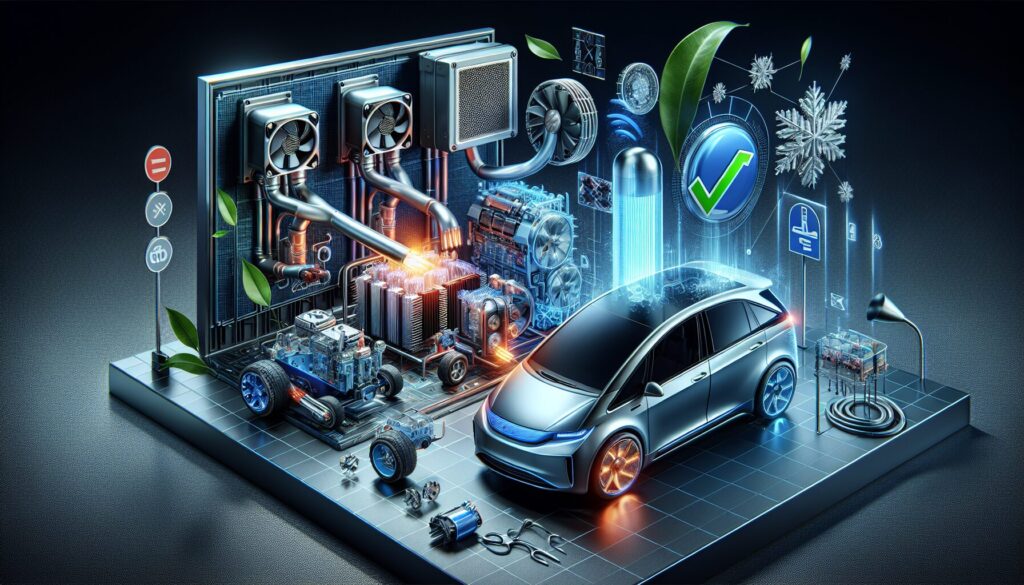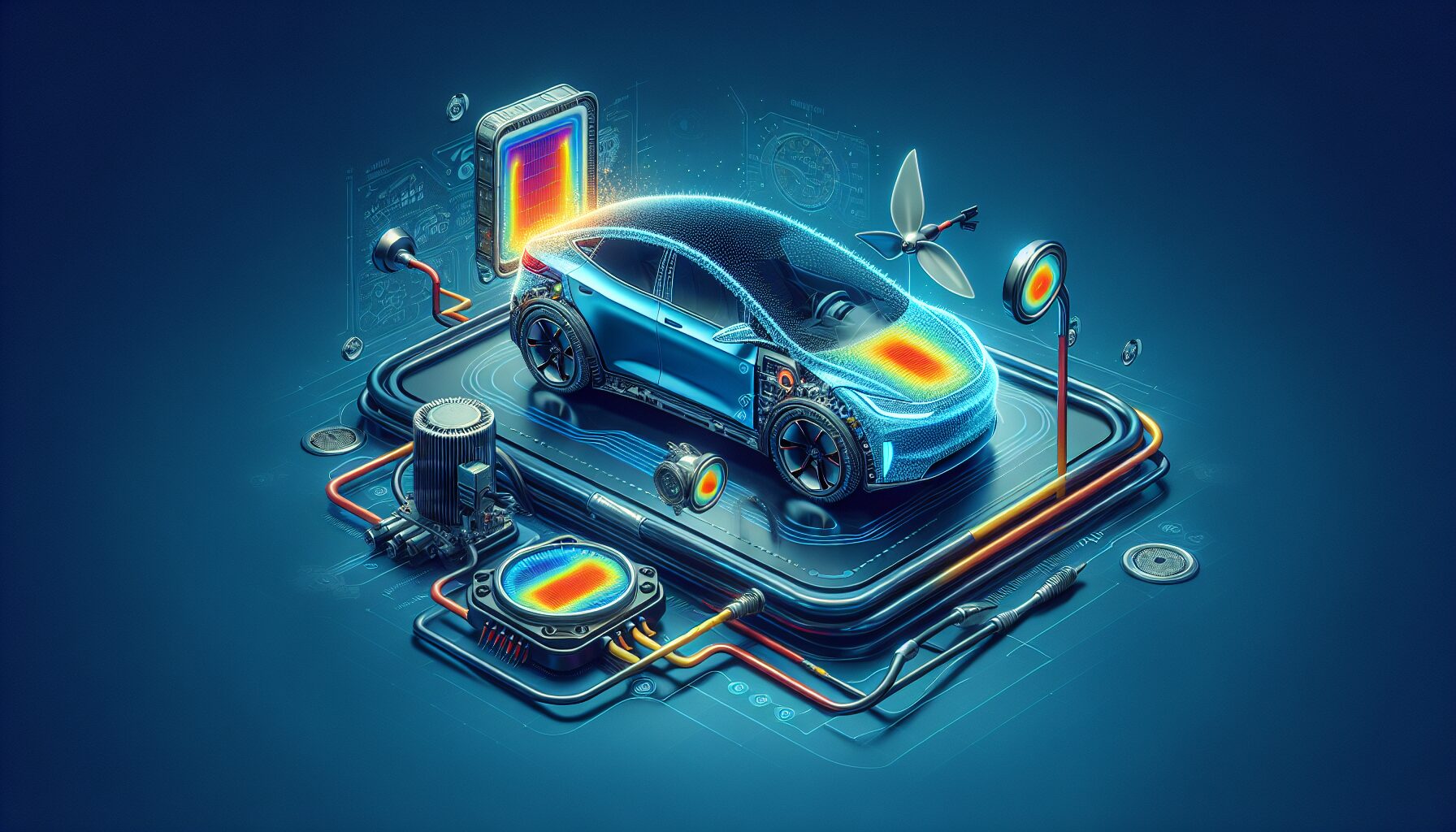Imagine cruising down the highway in your electric vehicle, feeling the thrill of smooth acceleration powered by cutting-edge technology. But, did you know that the efficiency of your EV relies heavily on how well it manages heat? That’s right! Effective thermal management is crucial in ensuring your vehicle performs at its best, all while maintaining battery health and longevity. One of the coolest (pun intended) elements in this domain is phase change materials. These nifty substances absorb and release heat as they change states, helping regulate temperature. Additionally, heat pipe technology, which uses the evaporation and condensation of liquid inside a sealed pipe, is another game-changer in this field. It provides efficient thermal conductivity. Moreover, liquid cooling systems, like those developed by Tesla, are pivotal in keeping temperatures in check. So, buckle up as we delve into the fascinating world of optimizing EV thermal management!
Related: An Expert's Guide to Thermal management systems in electric vehicles.
Understanding the Basics of EV Thermal Management
Delving into EV thermal management is like opening a treasure chest of tech wonders! I remember the first time I dived into a Computational Fluid Dynamics (CFD) simulation. It was mesmerizing to see how airflow around battery cells affects temperature regulation. It’s such a critical process for ensuring EVs perform optimally, especially under challenging conditions.
Managing heat in electric vehicles involves balancing multiple factors. Phase Change Materials (PCMs) play a vital role in this dance. They absorb excess heat and release it when the temperature drops. It’s like having a mini climate control system within your vehicle’s components. When I explored liquid cooling loop designs, I was amazed by their efficiency. They circulate coolant fluid around the battery pack, drawing away heat. This keeps everything running smoothly.
The Role of Heat Pipe Technology
Heat pipe technology is another fascinating component. It transfers heat through evaporation and condensation. Imagine a silent transporter for thermal energy! These pipes are essential for spreading the heat evenly, preventing hotspots. I once collaborated with a team to optimize a heat pipe system for an EV prototype. The results were incredible! We saw improved performance and longevity in the vehicle’s batteries.
Organizations like `Tesla` and `Panasonic` are constantly pushing the boundaries of thermal management. Their innovations inspire many of us in the field to keep improving EV systems. Understanding these basics is just the start. When you grasp how these elements work together, optimizing thermal management becomes second nature.
Choosing the Right Cooling Systems

When it comes to choosing the right cooling systems for your electric vehicle, it’s a bit like picking the perfect outfit for unpredictable weather. You’ve got to consider different factors to ensure optimal performance. I remember tinkering with my first DIY electric go-kart. I was so excited but quickly realized the importance of a good Battery Thermal Management System (BTMS). I had to rely on my knowledge of Computational Fluid Dynamics simulations to prevent the battery from overheating, especially during those spirited rides on hot summer days.
First, think about your EV’s specific needs. Do you need something robust for high-performance driving, or is your priority more on efficiency for city commutes? Each type of cooling system has its strengths, and understanding the nuances can help you make a smart choice.
Considering the Environment
Different climates demand different cooling solutions. If you’re driving in a hot, arid region, liquid cooling systems might be your best bet. They offer consistent thermal management and can handle extreme temperatures. On the other hand, in milder climates, heat pipe technology might suffice, providing efficient and lightweight cooling. Interestingly, a study by National Renewable Energy Laboratory found that optimizing a vehicle’s thermal management can improve battery lifespan significantly.
Additionally, look into manufacturers who are innovating in this space. Companies like `Tesla` and `Rivian` are pushing the boundaries with their advanced thermal solutions. They’re not just using phase change materials; they’re also pioneering new approaches to keep their systems cool under pressure. So, dive in, explore your options, and find the cooling system that best fits your EV’s needs. After all, a well-managed thermal system is key to a happy and efficient electric vehicle.
Implementing Advanced Materials for Better Heat Dissipation
When it comes to enhancing the heat dissipation in electric vehicles, advanced materials are game changers. Let me tell you, I once experimented with battery thermal interface materials (TIMs) in a small project. It was fascinating to see how these materials could dramatically improve thermal conductivity. They’re like the unsung heroes, helping transfer heat away from critical components. Also, phase change materials offer a nifty solution for thermal regulation. They absorb and release heat, keeping temperatures in check without any active cooling. It’s like having an invisible thermostat working tirelessly for your EV!
However, don’t overlook liquid cooling systems paired with microchannel heat exchangers. These systems efficiently manage heat, boosting performance. I remember chatting with a fellow enthusiast about the intricacies of these systems. We marveled at the tiny microchannels that maximize surface area for heat transfer. It’s amazing how such a small detail can make such a big difference!
Choosing the Right Materials
Additionally, selecting the right materials involves considering factors like cost, durability, and compatibility. It’s not just about throwing in the fanciest tech available. You’ve got to think about your EV’s specific needs. For example, the National Renewable Energy Laboratory offers great insights into material properties and their impact on thermal management. Furthermore, understanding the interplay between these materials and systems can unlock real benefits. Curious about more detailed strategies? Check out our expert guide on thermal management systems in electric vehicles.
Leveraging Software for Thermal Management
Optimising thermal management in electric vehicles (EVs) is like orchestrating a symphony, where every note counts. Software tools have become the maestros, leading the way to harmony. Once, while tinkering with a friend’s EV project, I saw firsthand how Computational Fluid Dynamics (CFD) analysis transformed our understanding. It was like watching a puzzle come together. The insights we gained on airflow and heat distribution were mind-blowing. It felt like unveiling a hidden world within the vehicle.
Software isn’t just a tool—it’s the secret weapon in the arsenal. Imagine using CFD to visualize how your EV’s liquid cooling systems interact under various conditions. This kind of precision is invaluable. You can pinpoint inefficiencies and optimize performance with surgical accuracy. Additionally, integrating battery thermal interface materials (TIMs) into the software model lets you simulate real-world scenarios, enhancing reliability and efficiency. It’s like having a crystal ball for your vehicle’s thermal health.
Advanced Software Tools
Exploring the capabilities of advanced software can be thrilling. Tools from organizations like the National Renewable Energy Laboratory offer cutting-edge solutions. They provide insights into phase change materials and heat pipe technology applications. These tools enable engineers to push boundaries, ensuring EVs remain cool and efficient. The software allows for rapid prototyping and testing, saving time and resources. It’s an engineer’s dream come true.
Incorporating these advanced tools into your EV design process is like having a backstage pass to a concert. You get to see how everything works together in perfect harmony. It’s not just about keeping the vehicle cool; it’s about unleashing its full potential. With the right software, you’re not just maintaining your EV; you’re elevating it to new heights. What a thrilling journey this is!
Maintenance Tips for Optimal Performance
Keeping your EV’s thermal management system in tip-top shape is key for optimal performance. I remember when I first dabbled with this, I was amazed by how much a well-maintained system could enhance efficiency and lifespan. Let’s dive into some practical tips that can make a real difference.
First, regularly inspect your phase change materials. These materials are crucial for managing temperature fluctuations. A small inconsistency can lead to bigger issues down the road. I once noticed a slight dip in performance and discovered that the phase change materials were not functioning optimally. A quick check and adjustment saved me from potential headaches.
Next up, keep an eye on your heat pipe technology. Ensure there are no blockages or wear and tear. Any impediment can reduce the system’s efficiency. I learned this the hard way when a minor obstruction in the heat pipes led to overheating issues. Regular maintenance can prevent such problems.
Monitor Your Cooling Systems
Your liquid cooling system is another area to watch closely. Ensure the fluid levels are adequate and the quality of the liquid is up to standard. I once ignored this, and it resulted in subpar performance during a long drive. A simple routine check can prevent this. Additionally, run occasional Computational Fluid Dynamics simulations. They help in predicting potential issues and optimizing the thermal management system’s performance.
Finally, don’t forget the importance of battery thermal interface materials (TIMs). These components play a vital role in conducting heat away from the battery. Regular checks can ensure they remain effective. Organizations like National Renewable Energy Laboratory offer great resources to help stay informed on best practices.
Assessing and Improving Insulation Techniques

When I first dabbled in the world of EVs, I was fascinated by how insulation techniques could significantly impact thermal management. I remember diving deep into the nuances of Phase Change Materials (PCM) and how they play a crucial role in maintaining optimal battery temperatures. It’s not just about keeping things cool; it’s about ensuring efficiency and longevity. However, a common oversight is assessing existing insulation methods. Regular checks can reveal inefficiencies that could be costing you in performance.
Additionally, employing Computational Fluid Dynamics (CFD) simulations can be a game-changer. These simulations allow for a detailed analysis of heat flow and insulation effectiveness. By identifying hotspots and areas of heat loss, you can tailor insulation strategies to your specific EV model. This approach is akin to having a thermal blueprint, guiding you to make precise improvements.
Innovative Materials and Techniques
Moreover, exploring new insulation materials can lead to significant improvements. Battery Thermal Interface Materials (TIMs) are pivotal in this regard. They enhance the transfer of heat away from critical components, ensuring the system remains stable. In my experience, integrating advanced TIMs resulted in a noticeable boost in thermal regulation. It’s like upgrading from a wool sweater to a high-tech thermal jacket.
Furthermore, organizations like the National Renewable Energy Laboratory are at the forefront of developing cutting-edge insulation technology. Collaborating with such entities can provide insights that are both innovative and practical. Therefore, don’t shy away from reaching out to experts who can offer tailored advice for your EV. Optimizing these techniques ensures that you’re not just keeping your EV running smoothly, but also extending its lifespan. It’s a win-win situation for both efficiency and sustainability.
Innovative Trends in EV Thermal Management
Exploring the latest trends in EV thermal management is like diving into a world of endless possibilities. I remember the first time I saw a Phase Change Material (PCM) integrated into an electric vehicle’s battery system. The precision and efficiency of the setup were impressive. It was like witnessing innovation in motion, and it left me eager to learn more. PCMs are now essential for optimizing battery temperature, making them a crucial part of energy efficiency strategies.
However, it’s not just about PCMs. The role of Computational Fluid Dynamics (CFD) is super exciting too. CFD simulations allow engineers to visualize and optimize thermal management systems before they’re even built. This means fewer surprises during implementation, saving both time and resources. Plus, it’s a bit like solving a complex puzzle, which I personally find thrilling! Liquid Cooling Loop Design has also made leaps and bounds. It’s fascinating to see how these systems maintain optimal temperatures, even under heavy loads.
Collaborations and Future Directions
Collaborations with institutions like the National Renewable Energy Laboratory are pushing the boundaries of what’s possible. They’re working on cutting-edge technologies that make EVs more efficient and reliable. Additionally, microchannel heat exchangers are becoming increasingly popular. These tiny marvels offer enhanced heat transfer, which is a game-changer for compact spaces. It’s incredible to think about how far we’ve come and where we’re headed. Innovators are constantly pushing limits, ensuring that EV thermal management continues to evolve and excite. As we embrace these trends, the future of electric vehicles looks brighter and more sustainable than ever.
Conclusion
Ultimately, the world of EV thermal management is a dynamic and innovative landscape, where advanced materials, cutting-edge technologies, and meticulous design converge to optimize performance and enhance sustainability. By understanding and implementing these strategies, we not only ensure the longevity and efficiency of electric vehicles but also pave the way for a cleaner, more sustainable future. Keep exploring and stay charged up!
Continue Exploring
Ready to revolutionize your understanding of electric vehicles? Dive into the world of cutting-edge thermal systems that power the future of EVs. Don't miss these 10 inspiring examples that redefine efficiency and innovation!
Frequently Asked Questions
What are the best practices for improving thermal management in electric vehicles?
Improving thermal management in electric vehicles involves using advanced cooling technologies, integrating phase change materials, optimizing battery placement, and employing smart software for temperature regulation. These methods help maintain optimal operating temperatures, enhance battery efficiency, and prolong vehicle lifespan.
How does thermal management impact the performance of electric vehicle batteries?
Thermal management significantly impacts electric vehicle battery performance by maintaining the optimal temperature range. Effective thermal management prevents overheating, which can degrade battery cells, reduce efficiency, and shorten battery life. Conversely, proper cooling ensures stable performance and maximizes the battery’s energy capacity.
Why is efficient thermal management crucial for electric vehicle longevity?
Efficient thermal management is crucial for electric vehicle longevity because it helps prevent extreme temperatures that can damage critical components. By maintaining a stable thermal environment, it reduces wear and tear, enhances overall vehicle reliability, and ensures that both the battery and vehicle systems operate efficiently over time.


Leave a Reply